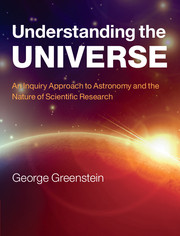Book contents
- Frontmatter
- Contents
- Preface
- Acknowledgments
- Part I Introducing steps to astronomy
- 1 The sky
- 2 The origins of astronomy
- 3 Newton's laws: gravity and orbits
- 4 Light
- 5 The astronomers’ tools: telescopes and space probes
- Part II The Solar System
- Part III Introducing stars
- Part IV Introducing galaxies and the Universe
- Epilog
- Appendix I The small-angle formula
- Appendix II Exponential notation
- Appendix III The Solar System
- Appendix IV The closest and brightest stars
- Appendix V Physical and astronomical constants
- Appendix VI Conversion factors
- Appendix VII Constellation maps
- Glossary
- Figure Credits
- Index
- Plate section
4 - Light
from Part I - Introducing steps to astronomy
Published online by Cambridge University Press: 05 February 2013
- Frontmatter
- Contents
- Preface
- Acknowledgments
- Part I Introducing steps to astronomy
- 1 The sky
- 2 The origins of astronomy
- 3 Newton's laws: gravity and orbits
- 4 Light
- 5 The astronomers’ tools: telescopes and space probes
- Part II The Solar System
- Part III Introducing stars
- Part IV Introducing galaxies and the Universe
- Epilog
- Appendix I The small-angle formula
- Appendix II Exponential notation
- Appendix III The Solar System
- Appendix IV The closest and brightest stars
- Appendix V Physical and astronomical constants
- Appendix VI Conversion factors
- Appendix VII Constellation maps
- Glossary
- Figure Credits
- Index
- Plate section
Summary
Astronomy faces a difficulty not shared by other sciences: we cannot get our hands on what we study. The geologist can pick up a rock and examine it; the biologist can dissect an animal. But among all the objects in the Universe, only the Moon, Venus, Mars, the satellite Titan of Saturn and a few comets and asteroids have actually been touched by spacecraft. The rest of the cosmos we are forced to study from afar.
Luckily, the Universe is continually broadcasting information to us, coded into light – or, more generally, electromagnetic radiation. It is by studying this light that we gain information about the cosmos. Indeed, until the advent of the space program and its robotic landers, this was the only means we had of gathering information about the cosmos.
In this chapter we will begin our study of light by discussing the concept of brightness, and then move on to the wave nature of light and the Doppler effect. Next we will consider the spectrum of light, both the continuous spectrum and spectral lines. It is truly amazing how much we can learn simply by gazing carefully at things.
Information
- Type
- Chapter
- Information
- Understanding the UniverseAn Inquiry Approach to Astronomy and the Nature of Scientific Research, pp. 89 - 115Publisher: Cambridge University PressPrint publication year: 2013
